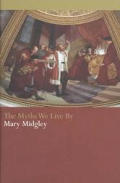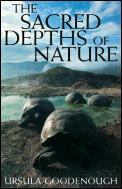bookshelf
Science and its metaphors
by Christopher L. Walton
Which side are you on? Whether the subject is politics or religion or family history, the question is always loaded. The truth is that people are almost always on several sides at the same time, as a parent knows when punishing a beloved but errant child, or as a loyal citizen knows when criticizing her government, or as a homeowner knows when confronted by a property tax referendum. But the question persists, dividing the world into friends and foes.
Sometimes we need a good push to sacrifice one loyalty to another more worthy. But more often we are urged to take sides in someone else’s cause. This is why the question appeals to demagogues. It puts us in the uncomfortable position of needing to decide whether we prefer these new allies or can bear their enmity. For this reason, the question always deserves heightened moral scrutiny.
Consider, for example, the call to arms this summer from two well-known science writers, Richard Dawkins and Daniel C. Dennett. Writing in the New York Times, Dennett, a philosophy professor and author of Darwin’s Dangerous Idea, urged champions of Enlightenment values and scientific rationality to call themselves “brights.”
“A bright is a person with a naturalist as opposed to a supernaturalist world view,” he explained. “We brights don’t believe in ghosts or elves or the Easter Bunny—or God. We disagree about many things, and hold a variety of views about morality, politics and the meaning of life, but we share a disbelief in black magic—and life after death.”
Dawkins, author of The Selfish Gene and other widely read books on evolution, embraces “bright” as a way to burnish the reputation of atheists. “Those of us who subscribe to no religion; those of us whose view of the universe is natural rather than supernatural; those of us who rejoice in the real and scorn the false comfort of the unreal, we need a word of our own, a word like ‘gay,’” he wrote in the Guardian. “Like gay, it should be catchy: a potentially prolific meme. Like gay, it should be positive, warm, cheerful, bright.” Indeed.
So: Do you revere reason, truth, and progress? Do you oppose the forces of convention, small-mindedness, and weak-kneed obeisance to outmoded gods? Or are you, as Dawkins’s proposal all but explicitly suggests, a “dim”? What a choice! The two professors congratulate people who already share their point of view—we used to call them secular humanists—and encourage others to adopt it out of sympathy for some of its ideals. But their most effective appeal is simple snobbery. Are you in or out? Are you scientific and rational, or are you a hick?
The Unitarian Universalist tradition has historically affirmed both faith and reason, worship and science. Religious humanists, unlike their passionately secularist cousins, are not anti-religious; many see religious impulses as profoundly human and even natural, and actively cultivate them. But Dennett and Dawkins would have us believe that anything less than a bright, militant atheism is unscientific and therefore illegitimate. We can join their campaign against “creation science” and other anti-scientific political movements. But we are also being urged to take sides against ourselves. We should resist that temptation. Two recent books will help.
The British moral philosopher Mary Midgley observes in her riveting book, The Myths We Live By, that scientific words carry on a double life, and she wants to straighten them out. “Myths are not lies,” she writes. “Nor are they detached stories. They are imaginative patterns, networks of powerful symbols that suggest particular ways of interpreting the world. They shape its meaning.” Midgley argues that scientific language, when it leaves the laboratory, often turns quickly into mythology.
 |
| The Myths We Live By. Mary Midgley. Routledge, 2003; $29.95. |
This machine imagery has been so useful in many scientific contexts that many people no longer think of it as a metaphor but as a scientific fact. Thus, much as they might say “soot is just carbon” or “penguins are just birds,” they remark in passing that the human brain is just a computer made of meat. They don’t think of this as a metaphor at all.
And so while the myth of the machine runs wild in public discussions of genetics and the science of mind, people forget that physicists have found it less and less fundamental. “Indeed, physics has dropped the whole idea that the basic structure of matter is bound to prove perfectly simple, an idea that seemed obvious to seventeenth-century thinkers and one that made the abstractions of the machine model look plausible.” Midgley’s creed is that simplicity is highly overrated and frequently dangerous.
She bursts the hot-air balloons of bio-engineering advocates and biological reductionists with special glee, although it can be hard at times to remember that Midgley is focused on popular depictions of science—how we talk about science and determine its meaning—more than on actual research. (For all the talk about Dawkins’s “memes,” for example—the pseudoscientific idea that human culture is made up of discrete units analogous to genes or atoms—there is no field of science that studies them.) But it is for just this reason that Unitarian Universalists should pay careful attention to her book.
No one conducts scientific experiments in their Unitarian Universalist meeting houses on Sunday morning, even if the children are potting plants or learning about Charles Darwin. No one practices science in any classroom of a Unitarian Universalist seminary, either. Science—the work that scientists do—is revered, perhaps even idolized, in our religious movement, but as a religious movement we are not doing science ourselves. Yet for some Unitarian Universalists and for many self-described Humanists, science has become the touchstone for human values. We want our theology to be compatible with science, and some of us even treat science as our theology and ethics. Midgley cautions us that the authority of science should not go unexamined; there is no divine right to the “intellectual imperialism” some science advocates promote.
“Science, which has its own magnificent work to do, does not need to rush in and take over extraneous kinds of questions (historical, logical, ethical, linguistic or the like) as well,” she writes. “Lovers of physical science can be happy to see it as it is, as one great department of human thought among others which all cooperate in our efforts at understanding the world.” Midgley’s book deserves a wide audience.
Ursula Goodenough loves science. A molecular biologist by vocation, she explains that her unusual book, The Sacred Depths of Nature, grew out of a question she began asking after twenty-five years of scientific research: “Why are people religious? And then: Why am I not religious?” As a good experimentalist, she joined a Presbyterian church to find out. She has been an active participant for more than a decade—as a non-theist and devoted scientific naturalist, mind you—and admires the church’s ability “to elicit states of serious reflection, reverence, gratitude, and penance.” But as a scientist, she wanted to know whether those states depend on a supernatural worldview. She asks: “Was it possible to feel such religious emotions in the context of a fully modern, up-to-the-minute understanding of Nature?” She believes it is possible and sets out to present a scientifically credible story of the universe that elicits these religious emotions.
 |
| The Sacred Depths of Nature. Ursula Goodenough. Oxford University Press, 1998: $14.95. |
Aspects of the book are quite appealing. Her personal narrative will undoubtedly ring true for many Unitarian Universalists. Near the end of the book, she writes about her experience in church: “When I sing the hymns of faith in Jesus’ love, I am drawn by their intimacy, their allure, their poetry. But in the end, such faith is simply not available to me. I can’t do it. I lack the resources to render my capacity for love and my need to be loved to supernatural Beings. And so I have no choice but to pour these capacities and needs into earthly relationships, fragile and mortal and difficult as they often are.”
But science itself doesn’t supply as much of the book’s energy as Goodenough would like. She explains that consciousness and cultural phenomena like science, art, and religion are “emergent functions,” “processes that have no counterpart at simpler levels.” But she repeatedly explains their meaning by drawing analogies to the molecular level. This metaphorical use of molecular biology is illuminating—but it comes close to ignoring the fact that human experiences do not need to be explained at the cellular level in order to be meaningful at the human level. It is undoubtedly helpful to scientists when religious and cultural terms are translated into metaphors drawn from science, but the “epic of evolution” will not be replacing other cultural sources of human meaning any time soon. She writes that “we read the notes, we hear the emergent chords and harmonies, and we marvel at the emergent musical experience,” but most of us simply hear the music first and learn to study the notes on the paper later, if at all.
We should certainly advocate for greater scientific literacy, including in our churches, but I am struck by the fact that at the end of each chapter, when Goodenough addresses the meaning of science, she turns to poets, who build meaning out of metaphors, as do we all.
: 64-66